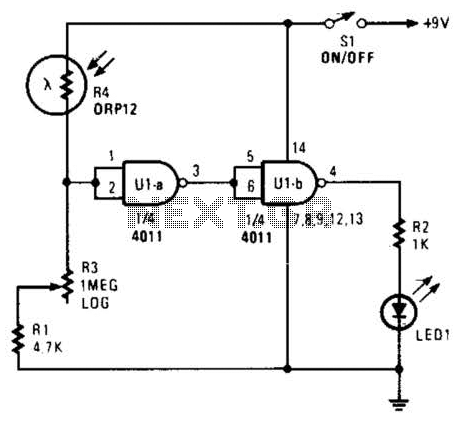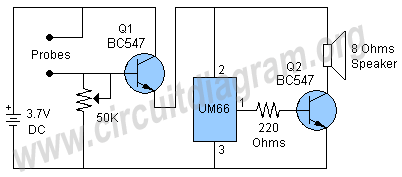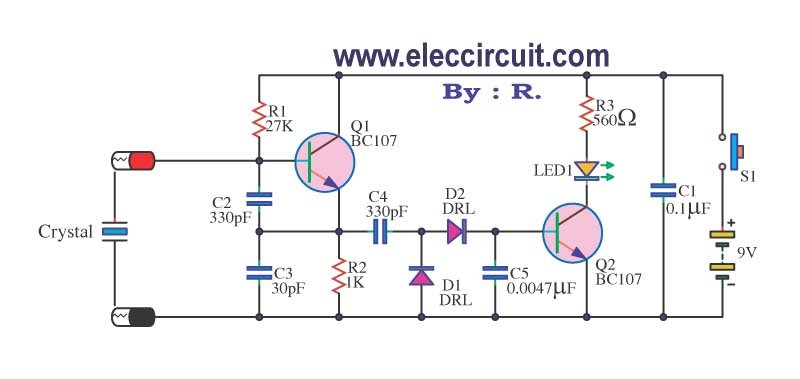
Enlarger Exposure Meter Circuit

Two gates of a 4011 IC are utilized as a comparator. When the resistance of R4 decreases, the voltage at pins 1 and 2 increases, resulting in a logic zero at pin 3. This causes pin 4 to go high, activating the LED. R3 is calibrated in light units or exposure time in seconds. To calibrate, adjust potentiometer R3 to the point where the LED is at the ON/OFF threshold, using a light level that is appropriate for correctly exposing a photographic print with a known enlarger and a known negative.
The described circuit employs two NAND gates from a 4011 quad NAND gate IC configured as a comparator, which effectively determines the light intensity based on the resistance of R4. The circuit operates by comparing the voltages at the inputs of the first NAND gate. As R4's resistance decreases, the voltage at the inputs (pins 1 and 2) rises, leading the output (pin 3) to transition to a low logic state (logic zero). This output change triggers the second NAND gate, causing its output (pin 4) to transition to a high state, which subsequently activates the LED.
In this configuration, R3 serves as a variable resistor or potentiometer, allowing for calibration based on the desired exposure time or light intensity. The calibration process involves adjusting R3 until the LED toggles at the threshold of ON/OFF, signifying the appropriate light level for exposure. The calibration can be performed using a known enlarger and a standard photographic negative, ensuring that the system can accurately indicate when the light is sufficient for correct exposure of photographic prints.
To enhance the functionality of this circuit, it may be beneficial to incorporate additional components such as a capacitor for signal smoothing or a transistor for driving larger loads, depending on the application requirements. Additionally, implementing a feedback mechanism could allow for more precise control over the exposure time by automatically adjusting R3 based on real-time light conditions. Overall, this comparator circuit is a practical solution for light measurement in photographic applications, providing a visual indication through the LED when optimal exposure conditions are met. Two gates of a 4011 arc used as a comparator. When the resistance of R4 decreases the voltage at pin 1 and 2 increases, producing a logic zero at pin 3, causing pin 4 to go high and activating the LED. R3 is calibrated in light units, or seconds exposure time. To calibrate, set pot R3 so as to just be on the LED ON/OFF threshold. With a light level that is suitable to correctly expose a photographic print, use a known enlarger and a known negative. 🔗 External reference
The described circuit employs two NAND gates from a 4011 quad NAND gate IC configured as a comparator, which effectively determines the light intensity based on the resistance of R4. The circuit operates by comparing the voltages at the inputs of the first NAND gate. As R4's resistance decreases, the voltage at the inputs (pins 1 and 2) rises, leading the output (pin 3) to transition to a low logic state (logic zero). This output change triggers the second NAND gate, causing its output (pin 4) to transition to a high state, which subsequently activates the LED.
In this configuration, R3 serves as a variable resistor or potentiometer, allowing for calibration based on the desired exposure time or light intensity. The calibration process involves adjusting R3 until the LED toggles at the threshold of ON/OFF, signifying the appropriate light level for exposure. The calibration can be performed using a known enlarger and a standard photographic negative, ensuring that the system can accurately indicate when the light is sufficient for correct exposure of photographic prints.
To enhance the functionality of this circuit, it may be beneficial to incorporate additional components such as a capacitor for signal smoothing or a transistor for driving larger loads, depending on the application requirements. Additionally, implementing a feedback mechanism could allow for more precise control over the exposure time by automatically adjusting R3 based on real-time light conditions. Overall, this comparator circuit is a practical solution for light measurement in photographic applications, providing a visual indication through the LED when optimal exposure conditions are met. Two gates of a 4011 arc used as a comparator. When the resistance of R4 decreases the voltage at pin 1 and 2 increases, producing a logic zero at pin 3, causing pin 4 to go high and activating the LED. R3 is calibrated in light units, or seconds exposure time. To calibrate, set pot R3 so as to just be on the LED ON/OFF threshold. With a light level that is suitable to correctly expose a photographic print, use a known enlarger and a known negative. 🔗 External reference
Warning: include(partials/cookie-banner.php): Failed to open stream: Permission denied in /var/www/html/nextgr/view-circuit.php on line 713
Warning: include(): Failed opening 'partials/cookie-banner.php' for inclusion (include_path='.:/usr/share/php') in /var/www/html/nextgr/view-circuit.php on line 713





